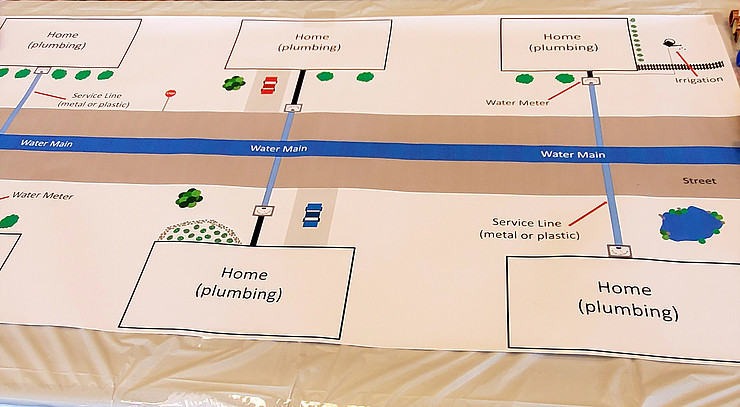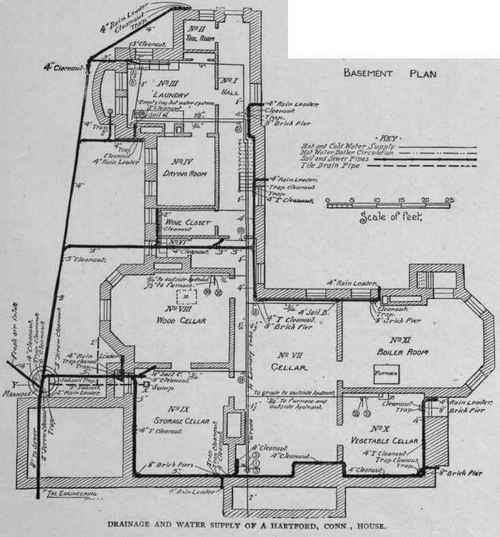The Layout of Your Home's Plumbing System Explained
The Layout of Your Home's Plumbing System Explained
Blog Article
Just how do you really feel about Plumbing Installation 101: All You Need to Know?

Comprehending just how your home's plumbing system works is vital for every house owner. From delivering tidy water for drinking, food preparation, and bathing to safely removing wastewater, a well-kept plumbing system is important for your family's wellness and comfort. In this thorough guide, we'll check out the intricate network that comprises your home's pipes and offer pointers on maintenance, upgrades, and managing common problems.
Intro
Your home's plumbing system is more than simply a network of pipes; it's a complicated system that guarantees you have access to clean water and effective wastewater elimination. Understanding its elements and just how they work together can assist you protect against expensive fixings and ensure everything runs smoothly.
Standard Components of a Plumbing System
Pipelines and Tubes
At the heart of your plumbing system are the pipelines and tubing that bring water throughout your home. These can be constructed from numerous products such as copper, PVC, or PEX, each with its advantages in terms of durability and cost-effectiveness.
Fixtures: Sinks, Toilets, Showers, and so on.
Components like sinks, bathrooms, showers, and tubs are where water is made use of in your house. Recognizing just how these components attach to the plumbing system assists in identifying issues and preparing upgrades.
Shutoffs and Shut-off Factors
Shutoffs manage the flow of water in your plumbing system. Shut-off valves are critical throughout emergency situations or when you require to make repair services, enabling you to isolate parts of the system without interrupting water flow to the whole residence.
Water Supply System
Key Water Line
The major water line attaches your home to the local water system or a personal well. It's where water enters your home and is distributed to various components.
Water Meter and Pressure Regulator
The water meter steps your water usage, while a stress regulator guarantees that water flows at a secure stress throughout your home's plumbing system, protecting against damage to pipelines and components.
Cold Water vs. Hot Water Lines
Recognizing the distinction in between cold water lines, which supply water straight from the primary, and warm water lines, which carry warmed water from the hot water heater, assists in troubleshooting and planning for upgrades.
Water drainage System
Drain Pipeline and Traps
Drain pipes lug wastewater far from sinks, showers, and toilets to the sewer or septic system. Catches avoid sewer gases from entering your home and additionally trap debris that could cause blockages.
Ventilation Pipes
Ventilation pipes permit air right into the drain system, stopping suction that might slow drainage and cause catches to empty. Proper air flow is necessary for preserving the integrity of your plumbing system.
Significance of Appropriate Drain
Making sure appropriate drain avoids back-ups and water damages. Consistently cleansing drains pipes and keeping traps can avoid expensive repair work and extend the life of your plumbing system.
Water Heater
Kinds Of Water Heaters
Water heaters can be tankless or conventional tank-style. Tankless heaters heat water on demand, while containers save warmed water for instant usage.
Updating Your Pipes System
Factors for Updating
Updating to water-efficient fixtures or replacing old pipelines can improve water quality, lower water costs, and boost the value of your home.
Modern Plumbing Technologies and Their Advantages
Discover technologies like clever leakage detectors, water-saving bathrooms, and energy-efficient water heaters that can conserve money and reduce environmental impact.
Cost Factors To Consider and ROI
Determine the in advance expenses versus long-term savings when taking into consideration pipes upgrades. Lots of upgrades spend for themselves with decreased utility bills and less repair services.
Exactly How Water Heaters Link to the Plumbing System
Comprehending how water heaters link to both the cold water supply and hot water circulation lines aids in detecting concerns like not enough warm water or leakages.
Upkeep Tips for Water Heaters
Regularly flushing your water heater to get rid of debris, examining the temperature settings, and examining for leaks can extend its lifespan and enhance power effectiveness.
Typical Plumbing Issues
Leaks and Their Causes
Leakages can take place because of aging pipelines, loosened installations, or high water stress. Attending to leaks promptly prevents water damages and mold development.
Obstructions and Obstructions
Blockages in drains and toilets are often caused by purging non-flushable items or a buildup of oil and hair. Utilizing drain displays and bearing in mind what decreases your drains can avoid clogs.
Signs of Pipes Issues to Watch For
Low tide pressure, slow drains pipes, foul odors, or abnormally high water expenses are indications of potential pipes problems that need to be resolved immediately.
Pipes Upkeep Tips
Routine Inspections and Checks
Schedule yearly plumbing assessments to catch problems early. Look for indications of leaks, corrosion, or mineral accumulation in taps and showerheads.
DIY Upkeep Tasks
Easy jobs like cleaning faucet aerators, checking for bathroom leakages using color tablet computers, or protecting revealed pipes in chilly environments can protect against major pipes concerns.
When to Call a Professional Plumbing Professional
Know when a plumbing problem calls for professional expertise. Trying intricate repairs without appropriate expertise can lead to more damages and greater repair work costs.
Tips for Decreasing Water Use
Straightforward habits like dealing with leaks quickly, taking much shorter showers, and running full tons of washing and dishes can conserve water and lower your energy costs.
Eco-Friendly Plumbing Options
Think about lasting pipes materials like bamboo for flooring, which is durable and environment-friendly, or recycled glass for counter tops.
Emergency situation Readiness
Actions to Take During a Plumbing Emergency situation
Know where your shut-off shutoffs are located and how to shut off the water system in case of a burst pipeline or significant leakage.
Relevance of Having Emergency Situation Calls Handy
Keep contact information for regional plumbing technicians or emergency situation solutions readily available for quick reaction during a plumbing situation.
Ecological Influence and Preservation
Water-Saving Components and Devices
Mounting low-flow taps, showerheads, and commodes can dramatically lower water use without giving up efficiency.
DIY Emergency Situation Fixes (When Suitable).
Momentary repairs like utilizing duct tape to spot a dripping pipeline or putting a container under a leaking faucet can decrease damages till an expert plumbing technician shows up.
Final thought.
Understanding the composition of your home's plumbing system empowers you to preserve it efficiently, saving time and money on fixings. By adhering to routine maintenance regimens and remaining notified about modern pipes modern technologies, you can ensure your plumbing system operates efficiently for years ahead.
HOW YOUR PLUMBING SYSTEM WORKS
Which Pipes Do What?
Blue lines = fresh water supply entering the building Red lines = hot water supply entering the building Grey lines = pipes carrying waste away from the building and venting pipes carrying gases away from the building (through the roof) YOUR MAIN PLUMBING SYSTEMS
There are two main plumbing systems that support your home s basic plumbing needs one that brings clean water into your home, and one that sends dirty water away from your home. Connected to the toilet, bath, shower, and other faucets in your home, these two systems keep your water flowing in the right directions.
ACCESSING FRESH WATER
Fresh and clean water is brought into your home through the main water supply line . Filtered through one pipe, this water is pressured to flow into the various fixtures in your home at any given time.
This water can be sourced from a well located on your property, a pond or river (mostly cottages), or, as in most cases, from the city s municipal water treatment centre. However, it is important to note that water that is untreated, such as the water siphoned from ponds or rivers, may not be safe to drink. Personal water supplies always need to be treated for hardness and contaminants before consumed.
MUNICIPAL WATER SUPPLIES
Improve taste and odour Remove sediment Eliminate hardness Reduce chlorine COLD WATER SUPPLY VS. HOT WATER SUPPLY
Cold water flows into your home or building through the service line, which then distributes hot or cold water to your fixtures. This line is most commonly run through a central column that runs floor to floor. Hot water runs in short and straight pipes as the longer the pipeline, the more heat that will be lost in the transfer. Having shorter pipes also allows residents to access hot water more quickly.
WASTE WATER SYSTEM
Your wastewater system is divided into two parts pipes that send wastewater away from your home and venting pipes that send sewer gas away from your home. Sewage water travels through pipes that flush the water and waste towards local sewers that are operated and managed by your city or town. Most sewer systems rely on gravity to move the wastewater to where it needs to go.
The further away from your toilet or sink, the larger wastewater pipes become. This allows for waste to be disposed of from various parts of your home or business at once without pipe blockages. The angle and flow of these pipes are also essential for keeping your waste pipes clear of build up.
https://harrisplumbing.ca/how-your-home-plumbing-system-works/

I ran across that page about The Inner Workings of Your Home's Plumbing while doing a search on the internet. Sharing is good. One never knows, you might be doing someone a favor. Thanks so much for your time invested reading it.
Click Here Report this page